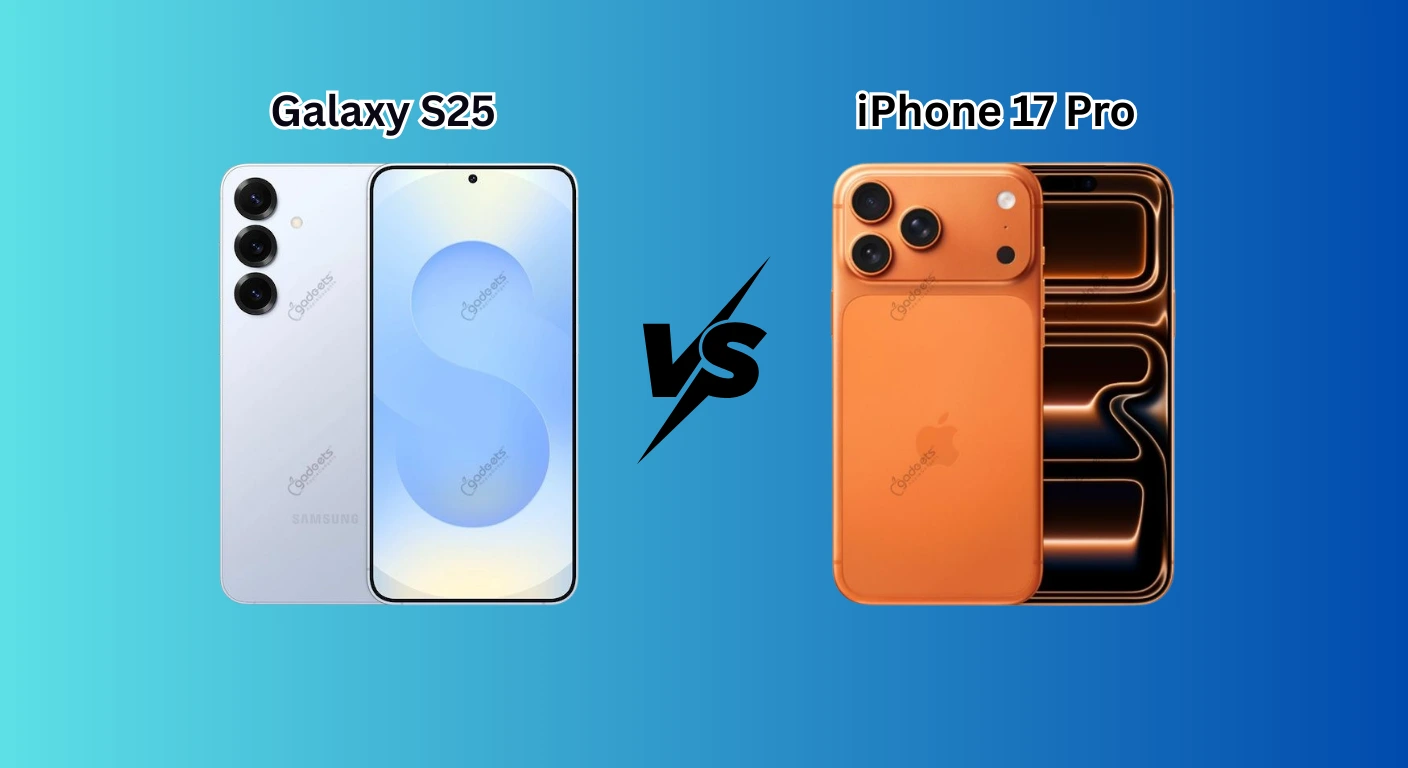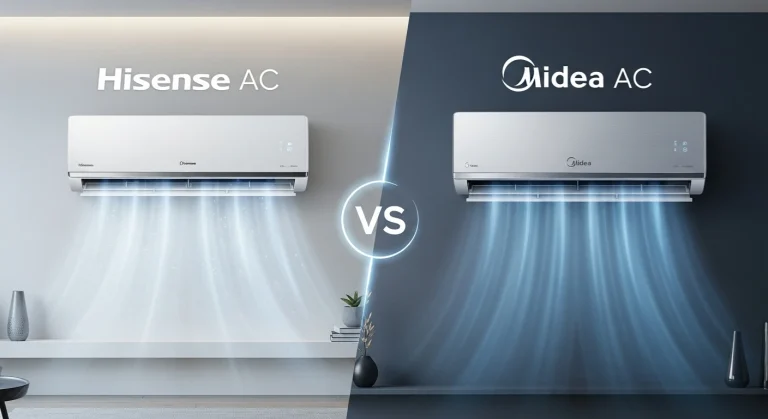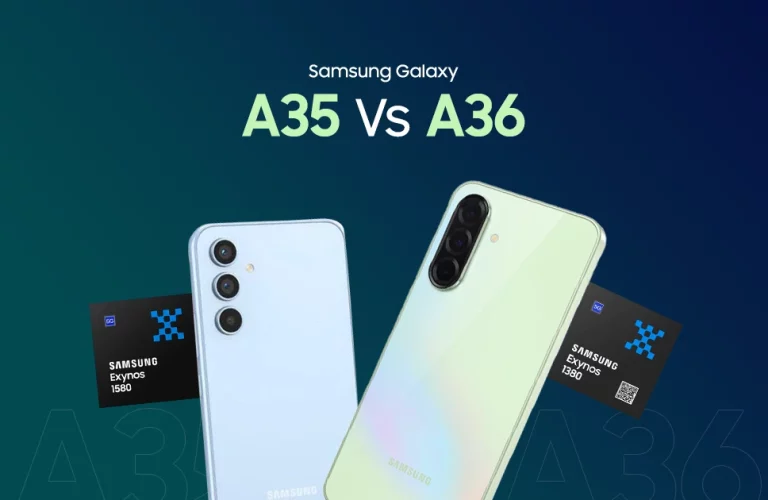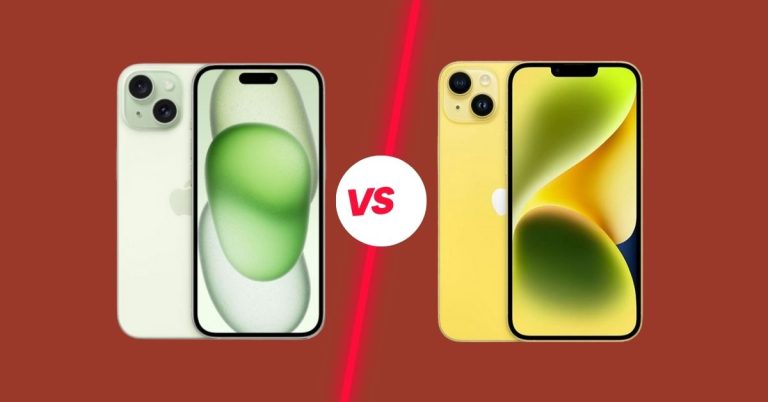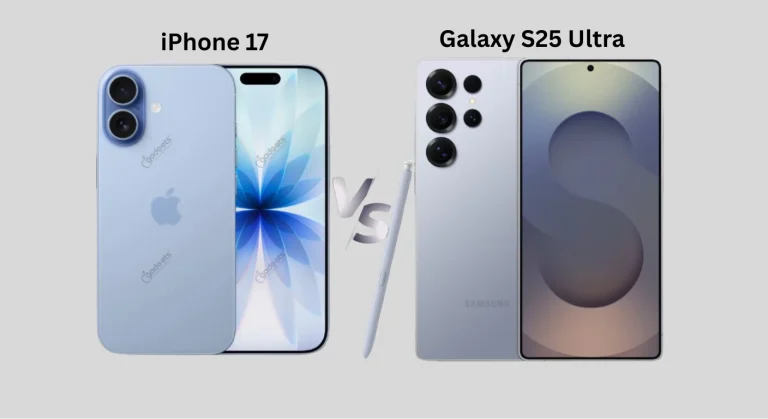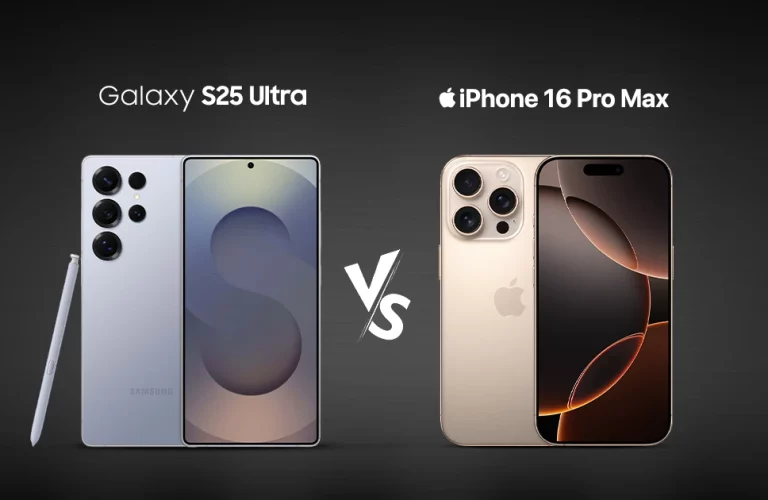iPhone 17 Pro vs Galaxy S25: Which Flagship Deserves Your Money & Respect?
Apple’s iPhone 17 series has finally arrived, and the excitement it has generated is hard to ignore. With the sleek iPhone 17, the ultra-thin iPhone Air, and the high-performance iPhone 17 Pro and Pro Max, Apple has shaken up its design philosophy in a way we have not seen in years.
But the stage never belongs to Apple alone. Whenever a new iPhone lands, the Samsung Galaxy S family steps up as the natural rival. This year the iPhone 17 Pro vs Galaxy S25 face-off feels sharper than ever, because both are sized just right, styled to impress, and built to perform. At the same time, the difference in pricing between these two makes the choice even more interesting for buyers weighing long-term value.
If you are not tied into Apple’s ecosystem or Samsung’s camp, this is your perfect stop. We will walk through design, display, battery, performance, cameras, and price with the kind of detail that matters in real world use. Now, let’s get started!
Design & Build
| iPhone 17 Pro | Galaxy S25 |
| Ceramic Shield 2 | Corning Gorilla Glass Victus 2 |
| Anodized Titanium Alloy Unibody | Aluminum Frame |
| IP68 Dust & Water Resistant | IP68 Dust Tight and Water Resistant |
On the Apple front we have a completely new material choice. An aerospace grade anodized titanium alloy unibody makes the iPhone 17 Pro feel like the toughest smartphone shell Apple has ever put together. Both front and back now use Ceramic Shield 2, which Apple says delivers three times more scratch and crack resistance. And it shows when you hold it.
Weighing 206 grams the iPhone 17 Pro feels noticeably more substantial than the S25, which sticks to an aluminum frame and glass front and back. Dimensionally the S25 is much shaved off while the iPhone’s new design rather added bulk from the predecessor iPhone 16 Pro.
Design language shifts on the back this year too. The iPhone 17 Pro adopts an edge to edge camera plateau that does more than alter the look. That raised platform makes room for a new sensor package that improves both OIS on the main cameras and front facing stabilization for selfies, and it rebalances how the phone sits in your palm.
Samsung keeps the traditional left aligned camera stack with lenses that sit proud and wobble when placed on a table. Two completely different philosophies. If pocketability and lightness are your priority Samsung wins this round. If build substance and refined handling matter more, the iPhone 17 Pro pulls ahead. priority Samsung wins this round. If build substance and refined handling matter more, the iPhone 17 Pro pulls ahead.
Key Takeaway:
- iPhone 17 Pro: Heavier, tougher, titanium build with functional camera plateau.
- Galaxy S25: Lighter, slimmer, easier to carry with classic glass and aluminum.
Read More: iPhone 17 VS Galaxy S25 Ultra
Display & Screen Features
| iPhone 17 Pro | Galaxy S25 |
| 6.3 inches | 6.2 inches |
| LTPO Super Retina XDR OLED | Dynamic LTPO AMOLED 2X |
| 120 Hz | 120 Hz |
| Up To 3000 Nits Peak Brightness | Up To 2600 Nits Peak Brightness |
When it comes to displays both Apple and Samsung know how to flex, and this year they show no mercy. Samsung being the OG in the display game sticks to its Dynamic LTPO AMOLED 2X panel. It looks stunning as always, but resolution is capped at 1080 x 2340, the classic spec for their screen ratio.
Apple, on the other hand, likes to play by its own rules. The iPhone 17 Pro lands with a 6.3 inch LTPO Super Retina XDR OLED that refreshes at 120 Hz, with a tweaked resolution of 1206 x 2622. It is sharper on paper, but the difference barely registers outside of deep dive gaming or pixel peeping.
The real tug of war is brightness and usability. Apple cranked peak brightness from 2000 to 3000 nits HBM this year, and it is no exaggeration to call that monumental. Outdoors under brutal sunlight, the iPhone 17 Pro holds its ground and delivers clarity with confidence. Samsung pushes to 2600 nits which is still excellent, but in direct sunlight you see where Apple’s extra headroom comes in.
That said, Samsung’s 91.1 percent screen to body ratio makes the smaller 6.2 inch Galaxy S25 feel pretty immersive in hand, almost as good as Apple’s 89.4 percent. Apple also touts a new anti reflective coating, but in practice Samsung continues to handle glare better with its tuned AMOLED recipe.
Key Takeaway:
- iPhone 17 Pro: Higher resolution, monumental brightness, perfect for HDR / outdoor clarity.
- Galaxy S25: Slimmer bezels, immersive ratio and practical anti glare for balanced visuals.

iPhone 17 Pro
- Design: Newly redesigned camera plateau with premium look
- Display: XDR OLED with superb resolution & quality viewing
- Performance: A19 Pro chip delivers extraordinary power
- Cameras: Superior triple rear camera lens for great photos & videos
- AI: Apple Intelligence features for unique experiences
- Connectivity: Superfast Wi-Fi 7 & built-in NFC payments
Performance & Hardware
| iPhone 17 Pro | Galaxy S25 |
| Apple A19 Pro (3 nm) | Snapdragon 8 Elite (3 nm) |
| Hexa-core CPU, Up to 4.26 GHz | Octa-core CPU Up to 4.47 GHz |
| 6 Core Apple GPU | Adreno 830 GPU |
| Max. 1TB ROM, 12GB RAM | NVMe Storage | Max. 512GB ROM, 12GB RAM | UFS 4.0 Storage |
| USB 3.2 Gen 2 + DisplayPort | USB 3.2 + DisplayPort 1.2 & OTG |
Now the main talk of the day: how does performance look in iPhone 17 Pro vs Galaxy S25?
Apple rewired the engine this time. The A19 Pro runs on a 3 nm node with a hexa core CPU up to 4.26 GHz and a 6 core Apple GPU. Bigger cache, so it keeps more data hot and ready. Storage goes NVMe up to 1 TB and RAM tops out at 12 GB, matching the S25 on paper but leaving the iPhone with a clear edge in sustained throughput and loading of huge media libraries.
On the Galaxy S25, the Snapdragon 8 Elite leads the Android charge with an octa core CPU up to 4.47 GHz and an Adreno 830 GPU – tuned for high frame rate gaming. The GPU and Samsung tuning make games feel electric. Real world gameplay on both phones is excellent, but the S25 gives a slightly livelier vibe in high frame scenarios.
Load times tell a different story. UFS 4.0 is fast, but it still cannot match NVMe peak data rates. So you will get into the game quickly on both, and once you are in, the experience is almost identical.
The USB and display connectivity story matters here because it affects file transfers and external peripheral uses. iPhone 17 Pro supports USB 3.2 Gen 2, which gives noticeably higher data throughput for large video transfers and backups. The Galaxy S25 supports USB 3.2 with OTG but is effectively limited to Gen 1 practical rates, which is roughly 500 Mbps lower in theory. Both support DisplayPort, so hooking either to an external monitor for gaming or work is straightforward.
Thermals and cooling are no longer an afterthought. Both phones use vapor chamber cooling, but with different materials and feel. Samsung uses a copper setup that conducts heat aggressively and can feel warmer in the hand. Apple uses an aluminum vapor chamber with de-ionized liquid and the new anodized titanium shell keeps surface temperatures feeling milder. Both manage sustained loads well but the tactile experience is completely different.
Key Takeaway
- iPhone 17 Pro: Faster NVMe storage and headroom, larger cache, USB 3.2 Gen 2 advantage for big file transfers.
- Galaxy S25: Higher clock speeds, gaming first GPU, UFS 4.0 storage and great real world performance.
Read More: iPhone 17 Vs iPhone Air
Camera & Photography
| iPhone 17 Pro | Galaxy S25 |
| Rear: Triple 48 MP Fusion (Wide + Periscope Telephoto + Ultrawide) | Rear: 50 MP Wide + 10 MP Telephoto + 12 MP Untrawide |
| Rear Video: 4K, 120 FPS | 10-bit HDR, Dolby Vision | Apple Log 2 | Rear Video: 8K, 30 FPS | 10-bit HDR, HDR10+ | Galaxy Log |
| Front: 18 MP Multi-aspect | OIS | 12 MP Wide | HDR10+ |
| Front Video: 4K 60 FPS | 1080p 120 FPS | Front Video: 4K, 60 FPS | 1080p, 30 FPS |
| Centre Stage | Best Face |
Let us get real. There is no single best camera layout for every user. Both flagships bring serious tools and different tastes win out. So, here we’ll look at the technical meat to keep opinions tight.
Apple went all in with a Fusion triple 48 MP setup that mixes wide, ultrawide and a proper periscope tele lens. The tele jumps up to 4X optical which is a real upgrade from the old crop tricks. The large camera plateau is not just for show. It houses bigger sensors and improved OIS, so long range shots and stabilized selfies actually work better.
Video is another strong card for Apple. You get 4K at 120 FPS, 10 bit HDR with Dolby Vision and Apple Log 2, plus ProRes RAW support. For creators who edit, that front end gives a much higher ceiling to play with light, color and contrast in post production.
Samsung’s answer is a very competent 50 MP main, 10 MP telephoto and 12 MP ultrawide. The S25 can record in 8K at 30 FPS and it handles daylight detail and contrast with punch. The trade off is style. Samsung tends to push color more and in low light that can look noisy or oversaturated to some naturalists like me, compared with the iPhone’s more natural, detailed output.
Front cameras are telling too. Apple moves to an 18 MP OIS capable front sensor with 4K at 60 FPS and center stage conveniences. Samsung keeps a solid 12 MP front with HDR10 plus and Best Face style framing, which is useful but lacks the same pro level capture ceiling of the iPhone 17.
Bottom line for me. If you want the higher editing headroom, stabilized long range shots and a front camera built for serious selfie video, the iPhone 17 Pro is the cleaner choice. If you need raw resolution on the main shooter and 8K recording for archival or experimental work, the Galaxy S25 is compelling. Either way you get flagship class imaging that will blow away most older phones.
Key Takeaway
- iPhone 17 Pro: Fusion triple 48 MP with 4X optical tele, stronger OIS, 4K @ 120 FPS, Pro level video tools and higher post production ceiling.
- Galaxy S25: 50 MP main, 8K @ 30 FPS, punchy daylight shots and flexible AI features, but slightly noisier and more saturated in low light.

Galaxy S25 Ultra 5G
- Design: Flat design on both sides with sleek titanium frame
- Display: Large AMOLED with high refresh rate
- Performance: Snapdragon 8 Elite for lightning-fast speed
- AI Features: Personalized AI-driven insights
- Cameras: Quad setup with powerful lenses to capture beyond
- Battery: Large capacity with flash charging for all-day power
Battery Life & Charging
| iPhone 17 Pro | Galaxy S25 |
| Li-Ion 3988 mAh / Li-Ion 4252 mAh | Li-Ion 4000 mAh |
| Wired: PD3.2 using AVS | Wired 25W PD3.0 |
| Wireless: 25W MagSafe / Qi2 | 4.5W Reverse Wired | Wireless: 15W Qi2 | 4.5W reverse wireless |
This is a tricky section because battery life and charging depend heavily on usage and two very different design philosophies. Still, past data helps us sketch the picture. The iPhone 17 Pro comes in two capacities; 3988 mAh (Nano-SIM) and 4252 mAh (eSIM). Taking the larger eSIM cell in consideration for a clearer picture, it’s about an 18% capacity increase over the 16 Pro.
Based on early user feedback, it’s delivering around 15 hours of usage, with many users getting 16+ hours. In real terms, the iPhone 17 looks set to outlast the Galaxy S25 in web, social and streaming workloads. Gaming on iPhone 17 Pro and 4K recording also run more consistently with less noticeable drain spikes compared to the Galaxy.
Samsung’s S25 sticks to a 4000 mAh pack. It charges fast and holds well, but drains quicker under streaming, gaming or browsing. Charging is where the S25 strikes back. A 25W PD 3.0 adapter tops up 53% in just 30 minutes, though it slows down like a sloth after 80%.
Apple now supports PD 3.2 with AVS and hits around 50% in just half an hour with a 40W charger. Definitely it’s slower in the sprint but smarter in the long run, often ending the day with more usable juice– thanks to iOS 26 efficiency tuning.
Both use vapor chamber cooling to handle heavy loads. Samsung’s approach feels warmer in hand, while Apple’s tuning stretches workloads more consistently. Your choice is clear cut – go Galaxy if quick charges are priority, go iPhone if all day reliability matters more.
Key Takeaway
- iPhone 17 Pro: Large cell with longer endurance, smarter all day efficiency.
- Galaxy S25: Smaller cell but faster charging, ideal for users who value quick top ups.
Software, Wireless & Ai Features
| iPhone 17 Pro | Galaxy S25 |
| iOS 26 | Android 15 |
| New Liquid Glass UI | Minimalist One UI 7 |
| Apple + ChatGPT, Visual Intelligence | Galaxy + Gemini AI |
| WiFi 7 + Bluetooth v6.0 | WiFi 7 + Bluetooth v5.4 |
iOS 26 is the headline here. Apple pushed a new “Liquid Glass” UI that has a floating magnifier, redesigned lock screen and cleaner camera app interface which literally change how iPhones now feel. The iOS 26 is supported back to iPhone 11, so the visual refresh and new power tuning land across many models including iPhone SE. These tweaks also help in battery management. On S25, you’re getting a minimalist One UI7 based on Android 15 which has more personalization headroom compared to the iOS 26.
On the AI end, the split is obvious. Apple finally offers “Visual Intelligence” to interact with Ai for what’s on your screen, just like Google powered Circle to Search; but you have to take a screenshot first.
Samsung leans hard on Google Gemini for Galaxy AI, giving S25 users immediate multimodal help in apps & games. Both approach AI differently but both are useful; ChatGPT-powered Apple Intelligence (Ai) feels more integrated and system first, while Galaxy’s is more open and research friendly.
Wireless comms & sensors are quite future proof on both devices. iPhone 17 Pro sports Apple’s N1 wireless chip for Wi-Fi 7, Bluetooth v6.0 and more precise Dual-frequency GPS + NavIC for satellite SOS.
Galaxy S25 ships with Wi-Fi 7 too, but Bluetooth is stuck to v5.4. The parity here may feel tiny, but differences become meaningful in latency and accessory tracking when comparing Bluetooth v5.4 with v6.0.
Key Takeaway
- iPhone 17 Pro: New Liquid Glass on iOS 26 with visual intelligence and hardware driven wireless / satellite safety.
- Galaxy S25: Deeper Google-Galaxy AI integrations, customizable One UI.
Read More: iPhone 17 Vs iPhone 17 Pro
Price & Value for Money
iPhone 17 Pro 256 GB sits at 1,54,990 BDT. The 150 – 165K range feels justified for pro level work. Genlock support, dual camera capture, upgraded Bluetooth and the A19 Pro’s raw power make this a tool for creators and pros. If you need highest fidelity video, pixel level control and seamless Mac continuity, this price is earned.
Galaxy S25 256 GB is 83,000 BDT. For almost half the cost of iPhone 17 Pro, you get Snapdragon 8 Elite, 8K capture, faster charging and Samsung DeX. It handles gaming, productivity and content work with ease. For most users this is the smarter, punchy flagship buy.
Key Takeaways
- iPhone 17 Pro: Premium price for pro creators who need Genlock, dual capture and top tier performance.
- Galaxy S25: Flagship performance at half the price for power users who want speed, 8K and fast recharges.
Let’s take a quick, side-by-side overview of the two uniquely appealing flagship choices before we jump to conclusion –
| Overview | |
| iPhone 17 Pro | Galaxy S25 |
| 149.6mm Height | 146.9mm Height |
| 206 Grams Weight | 162 Grams |
| 6.3 inches Display | 6.2 inches Display |
| 3988 / 4252 mAh Battery | 4000 mAh Battery |
So, Which Flagship Actually Fits Your Life?
iPhone 17 Pro is built for users who prize refinement and longevity. Titanium unibody and Ceramic Shield 2 easily survive daily knocks while feeling premium in hand. Longer battery life and iOS 26 deliver steady all day use for streaming, gaming and 4K capture. If you work across Mac and iPad, then Fusion camera and ProRes will make editing and sharing effortless.
In contrast, Samsung Galaxy S25 is for people who want flagship power with flexibility. Its lighter aluminum frame and slimmer profile make pocket carry easy. The display is vivid, charging is fast and Google Gemini powering the phone gives wide One UI customization and useful AI. Gaming feels lively and the Snapdragon 8 Elite keeps performance snappy. If you prefer Android openness, varied apps and quick top ups without Ultra pricing, this fits nicely.

Ifrad Mahbub is a tech enthusiast with more than two years of experience in writing about cutting-edge smart gadgets, cameras, and computers. He is passionate about exploring new technologies and engaging with like-minded professionals on the future of digital trends.

